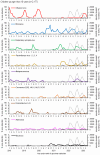Impact of COVID-19 on Respiratory Virus Infections in Children, Japan, 2018-2023
- PMID: 40071746
- PMCID: PMC11898005
- DOI: 10.1002/iid3.70176
Impact of COVID-19 on Respiratory Virus Infections in Children, Japan, 2018-2023
Abstract
Background: COVID-19, caused by SARS-CoV-2, was first documented in Japan in January 2020. We previously reported an increased risk of rhinovirus infections among children during the early phase of the COVID-19 pandemic. Here, we assessed the impact of COVID-19 on respiratory virus infections after SARS-CoV-2 spread nationwide.
Methods: We analyzed clinical specimens from 4012 patients with respiratory infections in Yokohama, Japan from January 2018 to April 2023.
Results: Among 15 representative respiratory viruses we detected (influenza virus, rhinovirus, coxsackievirus, echovirus, enterovirus, human coronavirus 229E, HKU1, NL63, and OC43, human metapneumovirus, human parainfluenza virus, human parechovirus, RSV, human adenovirus, human bocavirus, human parvovirus B19, herpes simplex virus type 1, and varicella-zoster virus), influenza was most affected by the COVID-19 pandemic, with no influenza viruses detected for nearly 3 years.
Conclusions: The decrease in influenza infections following the emergence of SARS-CoV-2 may have contributed to the previously reported increase in rhinovirus infections. The rhinovirus outbreak, rather than SARS-CoV-2, may have contributed to the decrease in enveloped virus infections (RSV, parainfluenza viruses, metapneumovirus, and coronavirus 229E, HKU1, NL63, and OC43), possibly due to negative virus-virus interactions.
Keywords: COVID‐19; SARS‐CoV‐2; influenza; respiratory syncytial virus; rhinovirus; viral interference.
© 2025 The Author(s). Immunity, Inflammation and Disease published by John Wiley & Sons Ltd.
Conflict of interest statement
The authors declare no conflicts of interest.
Figures




References
Publication types
MeSH terms
Grants and funding
LinkOut - more resources
Full Text Sources
Medical
Miscellaneous

